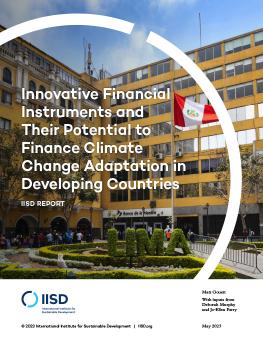
Innovative Financial Instruments and Their Potential to Finance Climate Change Adaptation in Developing Countries
Private sector investment is expected to play an important role in closing the current gap between available financing for adaptation and that which is required by developing countries. To date, however, the level of private sector financing in adaptation, particularly in developing countries, has been quite low. Innovative financial instruments have been cited as a means of overcoming this situation, but what is their real potential to spur greater investment in climate change adaptation?
-
According to the Climate Policy Initiative, in 2019-2020, private finance accounted for only 2.3% of funding for adaptation projects around the world.
-
Blended finance, private-public partnerships, and payment for ecosystem services arrangements are innovative financial instruments already being used in developing countries to attract private investment in adaptation actions.
-
Credit guarantees are used by multilateral development banks in developing countries to scale up private investment in infrastructure projects. But in 2021, they comprised less than 1% of the banks' finance for adaptation in low/middle-income economies.
This report explores the range of innovative financial instruments that could be used to scale up finance for adaptation. Drawing in part on insights gained from case studies from Kenya, Nepal, and Peru, the report identifies four interconnected lessons regarding the use of innovative financial instruments for climate change adaptation in developing countries:
- Blended finance arrangements that bring together concessional public capital and private capital have been and will continue to be the means through which private finance supports many adaptation projects.
- Packaging adaptation projects alongside projects that generate revenue is a way to increase flows to adaptation. As many adaptation projects do not provide a clear potential to generate sufficient revenue, packing them along with projects that generate other benefits—such as reductions in carbon emissions—may increase their attractiveness to private investors.
- Some financing arrangements that would be considered standard in one country or market could be considered innovative in another market. “Innovation” therefore does not necessarily mean the creation of new instruments but rather can involve the application of tested arrangements to a new sector, for a new purpose, or in a country where they have not been used before.
- In some geographic regions, grant and concessional finance from a public entity is the most suitable form of finance for certain adaptation projects. These projects should be identified and set aside when communicating with potential private sector investors.
Overall, there is a greater need to diversity how existing instruments, such as credit guarantees, are being used and to focus on their use in sectors where there is greater opportunity to meet the revenue generation expectations of private financiers. Through innovative approaches to combining existing instruments and matching them to specific projects, there is greater potential to increase private sector financing for adaptation.
Participating experts
You might also be interested in
The Landscape of Financing Strategies for Adaptation in Developing Countries
Draws insights from publicly available financing strategies for adaptation in developing countries and presents emerging lessons for their development.
Multilateral Development Bank Efforts to Mainstream Climate Adaptation
The paper explores the progress of four MDBs in mainstreaming climate adaptation in their developing country portfolios, specifically looking at experiences in Kenya, Nepal, and Peru.
Credit Enhancement for Sustainable Infrastructure
The paper identifies the demand and supply-side barriers for upscaling credit enhancement solutions for sustainable infrastructure projects.
Guiding Principles for the Preparation of Financing Strategies for Climate Change Adaptation in Developing Countries
This report provides seven guiding principles for effective financing strategies for climate change adaptation prepared by developing country governments.
